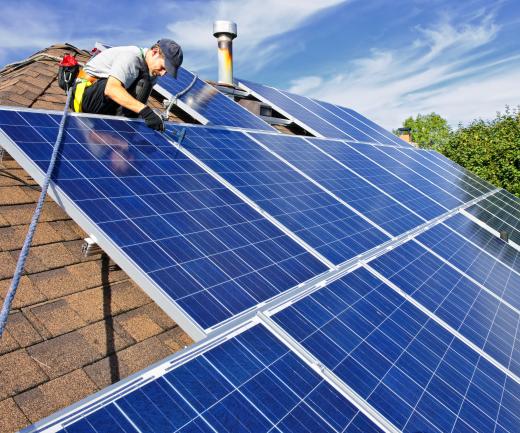Photovoltaic cells are devices that produce electricity directly from sunlight. Many photovoltaic cells put together form a solar array or solar panel. These cells convert light into electricity by harnessing the energy created when photons from sunlight knock electrons into a higher state of energy, within the cell itself. Photovoltaic cells are composed of layered materials which include two types of silicon, an anti-reflective coating, and a glass cover. The technology used to produce solar panels continues to advance, and may one day provide essentially free energy to power homes and businesses.
One of the most important parts of a photovoltaic cell is the material used as the semiconductor. Silicon is the most commonly-used semiconductor, but other options are available for certain applications, which can be less expensive than silicon. When light hits the semiconductor, a portion of the light energy is absorbed, causing the release of electrons. The electric current that results is what can be used as electricity, and it is collected by the metal contact grids on the top and bottom of solar cells.

Silicon by itself is not a very good conductor of electricity. In order to be used in a solar cell, silicon must be modified, or "doped," with other elements. Phosphorous and boron are the elements of choice for this purpose. A layer of silicon doped with phosphorous can take advantage of the fact that the latter element only has one electron in its outermost electron shell. This is the electron that can be knocked off by light energy.

In the other layer, the boron atoms have only three electrons in their outer shell, instead of four, which silicon has. This creates a spot for the extra electrons to go to, and this movement of electrons is what makes the electrical current. The two silicon layers also have opposite charges, which is what provides the voltage.
Silicon crystals are a naturally reflective material. When they are used in photovoltaic cells, they must have an anti-reflective coating placed on them, otherwise most of the solar energy that reaches the panel will be reflected without producing electricity. The anti-reflective coating is the single biggest factor affecting the efficiency of a properly constructed solar panel. However, even with this coating, only a relatively small amount of the light can be used to make electricity. As the technology advances, photovoltaic cells will likely increase in efficiency, making them more practical for everyday residential and industrial use.
